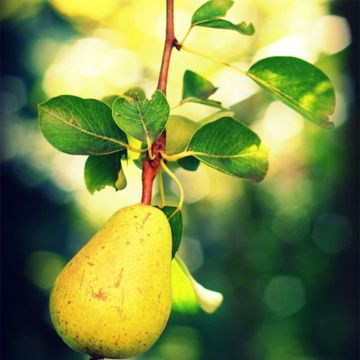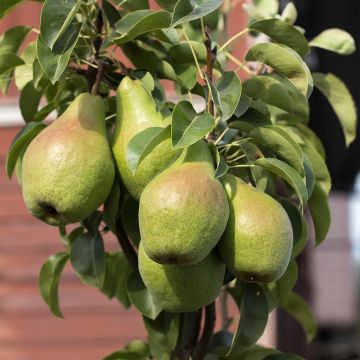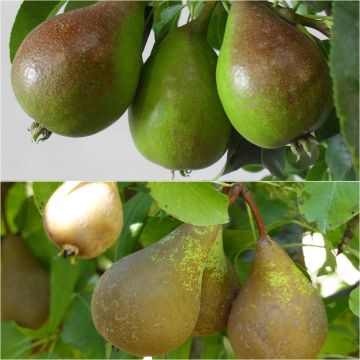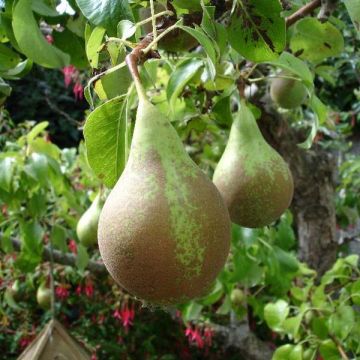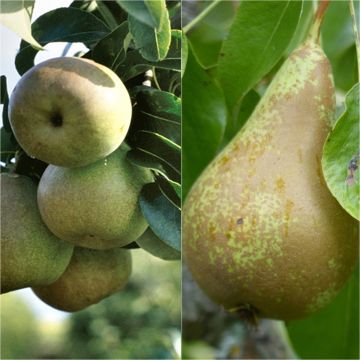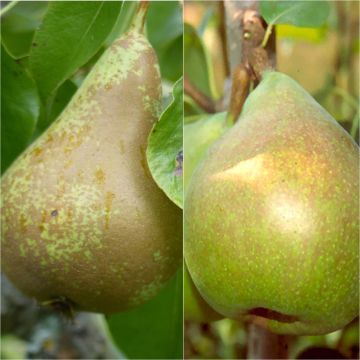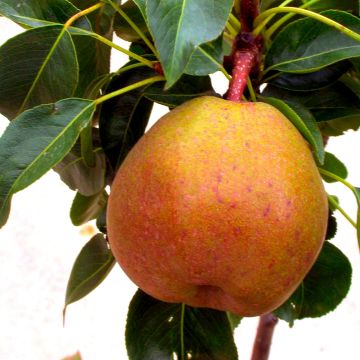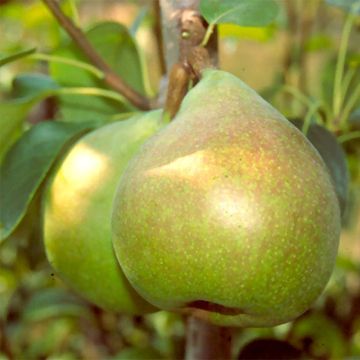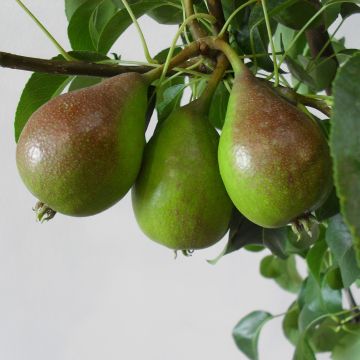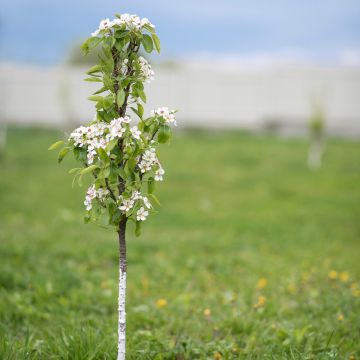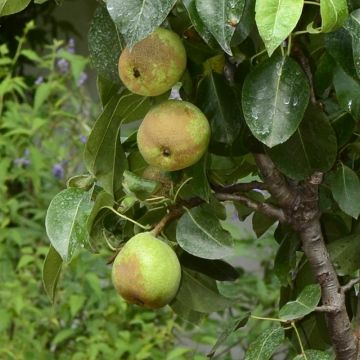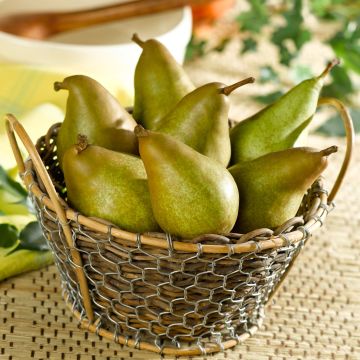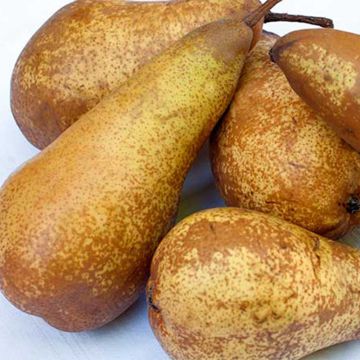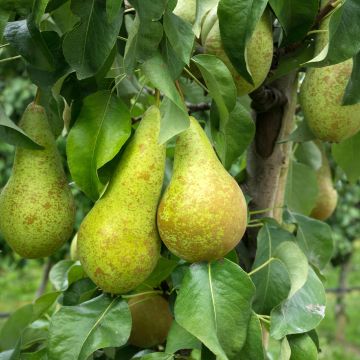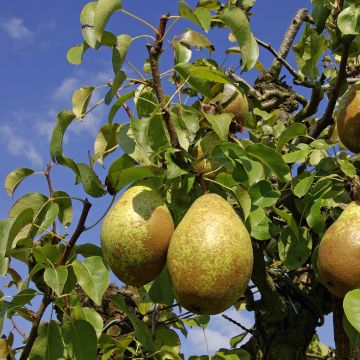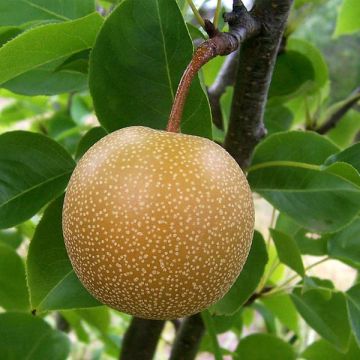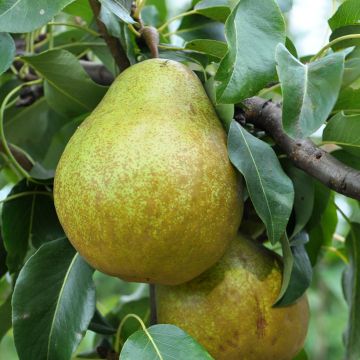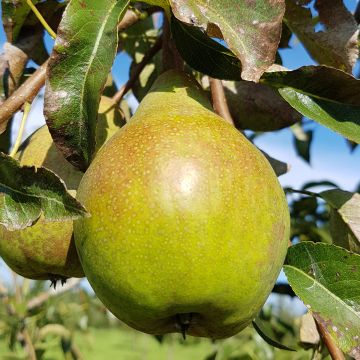Shipping country and language
Your country of residence may be:
Your country of residence is:
For a better user experience on our website, you can select:
Your shipping country:
Andorra
Austria
Belgium
Bulgaria
Canada
Chile
Croatia
Cyprus
Czechia
Denmark
Estonia
Finland
France
Germany
Greece
Hungary
Iceland
Ireland
Italy
Latvia
Lithuania
Luxembourg
Malta
Monaco
Netherlands
Poland
Portugal
Romania
Slovakia
Slovenia
Spain
Sweden
Switzerland
United Kingdom
We only deliver seed and bulb products to your country. If you add other products to your basket, they cannot be shipped.
Language:
French
German
Spanish
English
My Account
Hello
My wish lists
Plantfit
Log in / Register
Existing customer?
New customer?
Create an account to track your orders, access our customer service and, if you wish, make the most of our upcoming offers.
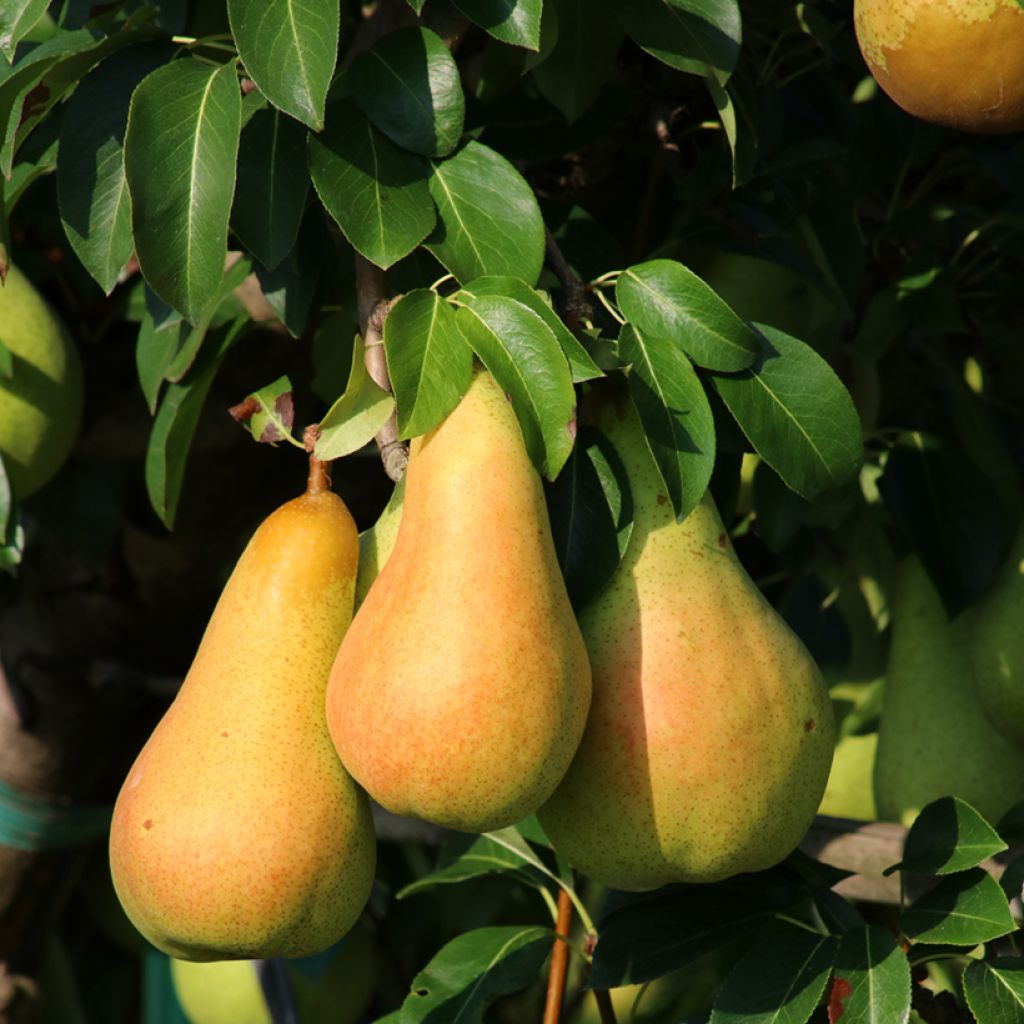

Poirier Grand champion
Pyrus communis Grand champion - Pear Tree
Pyrus communis Grand champion
Common Pear, European Pear
Why not try an alternative variety in stock?
View all →Order in the next for dispatch today!
Dispatch by letter from €3.90.
Delivery charge from €5.90 Oversize package delivery charge from €6.90.
More information
This item is not available in your country.
Schedule delivery date,
and select date in basket
This plant carries a 6 months recovery warranty
More information
We guarantee the quality of our plants for a full growing cycle, and will replace at our expense any plant that fails to recover under normal climatic and planting conditions.
Oversize package: home delivery by special carrier from €6.90 per order..
Express home delivery from €8.90.

Description
Pyrus communis 'Grand Champion' is an American variety that produces medium to large-sized pears. Their thick and slightly rough skin is bronze yellow, dotted with tan spots. It takes on pinkish hues when exposed to sunlight. Its non-granular white flesh is very fine, melting, juicy, very sweet, slightly acidic, and subtly fragrant. Harvesting takes place from mid-September to mid-October, with fruits reaching ripeness in November. Storage can be extended until the end of January. Subtly acidic and rich in sugar, it is a delicious pear to enjoy fresh. When cooked, it lends itself well to many sweet or savoury dishes. It is a partially self-fertile variety that requires the presence of other pear varieties nearby to improve pollination and increase the number of fruits. It has good disease resistance.
Pyrus communis belongs to the Rosaceae family. It originates from the forests of Western Asia. Its cultivation is widespread in Europe.
'Grand Champion' was discovered around 1936 in the United States. It is a mutation of the 'Gorham' variety. When mature, it can reach approximately 5m (16ft) in height and 4m (13ft) in spread. Its habit is ideal for tall forms (standard), low forms (bush), or espalier forms (fan-trained). Its deciduous foliage is composed of alternate large leaves, 8 to 10cm (3 to 4in) long. They are a glossy green that turns yellow-orange in autumn. Flowering occurs around mid-April, which generally protects it from frost. The single white flowers, 2 to 3cm (1in) in diameter, are grouped in umbels. They are nectar-bearing. The flowers can be destroyed by frosts of -2 to -3°C (28.4 to 26.6°F). It is a hardy tree that can withstand temperatures around -25°C (-13°F), making it suitable for cultivation in most regions, including high altitudes. This pear tree is self-sterile, meaning the flowers cannot self-pollinate. It therefore requires the presence of other pear varieties that flower at the same time. For example, the varieties 'Beurré Hardy', 'Conference', 'Doyenné du Comice', 'Jules Guyot', 'William's Bon Chrétien', and 'William's Rouge' are suitable for cross-pollination, thereby increasing the number of fruits.
'Grand Champion' is a high-yielding variety with rapid fruiting and abundant and regular fruit production. Harvesting begins from mid-September, with the pears ready to eat between November and January. Pears can be consumed both raw and cooked, in compotes, pastries, desserts, fruit salads, and mixed salads. They work well with cheeses or as an accompaniment to savoury dishes, alongside duck, white meat (poultry and lamb), or game. It is also perfect for making juice or syrup-soaked fruits. Pears have a moderate calorie content. They are rich in potassium, calcium, and magnesium, with a significant iron content. They contain vitamins C and E, antioxidants, and fibre. The fruits can be stored for 2 to 4 months after harvesting. Store in a cool, clean place, protected from light, at a temperature of around 8 to 10°C (46.4 to 50°F), or in a cold room, sealed off from outside air, at a temperature of 1 to 3°C (33.8 to 37.4°F).
Pear trees are some of the most popular fruit trees for our gardens. There is such a wide range of pear trees that it is easy to find the right variety.
Plant habit
Fruit
Flowering
Foliage
Botanical data
Pyrus
communis
Grand champion
Rosaceae
Common Pear, European Pear
Cultivar or hybrid
Other Pear trees
Planting and care
Choose a location sheltered from prevailing winds, especially in cooler regions. Ideally, plant it in full sun. Pear trees thrive in moist, rich soils without stagnant moisture, but they do not appreciate soils that are too dry or too chalky. Plant between October and March, outside of the freezing period. Container-grown trees can be planted all year round, except during periods of extreme heat or frost.
Loosen the soil deeply, and remove rocks and weeds. Add some gravel to improve drainage, if necessary. Dig a wide planting hole at least 3 times the size of the root ball. Separate the subsoil and topsoil. Mix crushed horn and organic matter (potting soil, compost, etc.) with the subsoil and pour this mixture into the bottom of the planting hole. Place the root ball, cover with the topsoil without burying the graft union, and firm it down. Water generously (about 10 litres). It may be beneficial to stake the pear tree by installing a guy wire system: plant 3 stakes in a triangle 50cm (20in) around the trunk and connect them together with pieces of wood. Protect the bark with a piece of rubber, for example, and attach the stakes to the trunk with metal wires. It is also possible to espalier it on a support (such as a U-shaped espalier or Verrier espalier).
For maintenance, apply well-rotted compost on the surface every autumn. In winter, add a small shovel of potash-rich wood ash to improve fruiting. Hoe around the base of the tree. Depending on your climate, water regularly during the first two or three years.
Pear trees can be susceptible to various diseases and pests. Spray with horsetail decoctions to prevent scab (brown spots on the leaves), brown rot (wilting of flowers and fruit rot on the tree), and powdery mildew (white powdery coating on the leaves). As for pests, the codling moth or fruit worm, a small caterpillar, can be controlled by installing bird and bat boxes that will attract beneficial predators. They can also be controlled by placing undulated cardboard strips along the trunk, or by bagging the fruits in brown paper. Spray a mixture of water and black soap if aphids attack.
Planting period
Intended location
Care
This item has not been reviewed yet - be the first to leave a review about it.
Haven't found what you were looking for?
Hardiness is the lowest winter temperature a plant can endure without suffering serious damage or even dying. However, hardiness is affected by location (a sheltered area, such as a patio), protection (winter cover) and soil type (hardiness is improved by well-drained soil).

Photo Sharing Terms & Conditions
In order to encourage gardeners to interact and share their experiences, Promesse de fleurs offers various media enabling content to be uploaded onto its Site - in particular via the ‘Photo sharing’ module.
The User agrees to refrain from:
- Posting any content that is illegal, prejudicial, insulting, racist, inciteful to hatred, revisionist, contrary to public decency, that infringes on privacy or on the privacy rights of third parties, in particular the publicity rights of persons and goods, intellectual property rights, or the right to privacy.
- Submitting content on behalf of a third party;
- Impersonate the identity of a third party and/or publish any personal information about a third party;
In general, the User undertakes to refrain from any unethical behaviour.
All Content (in particular text, comments, files, images, photos, videos, creative works, etc.), which may be subject to property or intellectual property rights, image or other private rights, shall remain the property of the User, subject to the limited rights granted by the terms of the licence granted by Promesse de fleurs as stated below. Users are at liberty to publish or not to publish such Content on the Site, notably via the ‘Photo Sharing’ facility, and accept that this Content shall be made public and freely accessible, notably on the Internet.
Users further acknowledge, undertake to have ,and guarantee that they hold all necessary rights and permissions to publish such material on the Site, in particular with regard to the legislation in force pertaining to any privacy, property, intellectual property, image, or contractual rights, or rights of any other nature. By publishing such Content on the Site, Users acknowledge accepting full liability as publishers of the Content within the meaning of the law, and grant Promesse de fleurs, free of charge, an inclusive, worldwide licence for the said Content for the entire duration of its publication, including all reproduction, representation, up/downloading, displaying, performing, transmission, and storage rights.
Users also grant permission for their name to be linked to the Content and accept that this link may not always be made available.
By engaging in posting material, Users consent to their Content becoming automatically accessible on the Internet, in particular on other sites and/or blogs and/or web pages of the Promesse de fleurs site, including in particular social pages and the Promesse de fleurs catalogue.
Users may secure the removal of entrusted content free of charge by issuing a simple request via our contact form.
The flowering period indicated on our website applies to countries and regions located in USDA zone 8 (France, the United Kingdom, Ireland, the Netherlands, etc.)
It will vary according to where you live:
- In zones 9 to 10 (Italy, Spain, Greece, etc.), flowering will occur about 2 to 4 weeks earlier.
- In zones 6 to 7 (Germany, Poland, Slovenia, and lower mountainous regions), flowering will be delayed by 2 to 3 weeks.
- In zone 5 (Central Europe, Scandinavia), blooming will be delayed by 3 to 5 weeks.
In temperate climates, pruning of spring-flowering shrubs (forsythia, spireas, etc.) should be done just after flowering.
Pruning of summer-flowering shrubs (Indian Lilac, Perovskia, etc.) can be done in winter or spring.
In cold regions as well as with frost-sensitive plants, avoid pruning too early when severe frosts may still occur.
The planting period indicated on our website applies to countries and regions located in USDA zone 8 (France, United Kingdom, Ireland, Netherlands).
It will vary according to where you live:
- In Mediterranean zones (Marseille, Madrid, Milan, etc.), autumn and winter are the best planting periods.
- In continental zones (Strasbourg, Munich, Vienna, etc.), delay planting by 2 to 3 weeks in spring and bring it forward by 2 to 4 weeks in autumn.
- In mountainous regions (the Alps, Pyrenees, Carpathians, etc.), it is best to plant in late spring (May-June) or late summer (August-September).
The harvesting period indicated on our website applies to countries and regions in USDA zone 8 (France, England, Ireland, the Netherlands).
In colder areas (Scandinavia, Poland, Austria...) fruit and vegetable harvests are likely to be delayed by 3-4 weeks.
In warmer areas (Italy, Spain, Greece, etc.), harvesting will probably take place earlier, depending on weather conditions.
The sowing periods indicated on our website apply to countries and regions within USDA Zone 8 (France, UK, Ireland, Netherlands).
In colder areas (Scandinavia, Poland, Austria...), delay any outdoor sowing by 3-4 weeks, or sow under glass.
In warmer climes (Italy, Spain, Greece, etc.), bring outdoor sowing forward by a few weeks.
